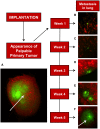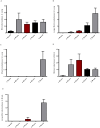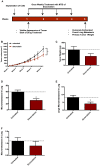Development and characterization of a preclinical model of breast cancer lung micrometastatic to macrometastatic progression
- PMID: 24878664
- PMCID: PMC4039511
- DOI: 10.1371/journal.pone.0098624
Development and characterization of a preclinical model of breast cancer lung micrometastatic to macrometastatic progression
Abstract
Most cancer patients die with metastatic disease, thus, good models that recapitulate the natural process of metastasis including a dormancy period with micrometastatic cells would be beneficial in developing treatment strategies. Herein we report a model of natural metastasis that balances time to complete experiments with a reasonable dormancy period, which can be used to better study metastatic progression. The basis for the model is a 4T1 triple negative syngeneic breast cancer model without resection of the primary tumor. A cell titration from 500 to 15,000 GFP tagged 4T1 cells implanted into fat pad number four of immune proficient eight week female BALB/cJ mice optimized speed of the model while possessing metastatic processes including dormancy and beginning of reactivation. The frequency of primary tumors was less than 50% in animals implanted with 500-1500 cells. Although implantation with over 10,000 cells resulted in 100% primary tumor development, the tumors and macrometastases formed were highly aggressive, lacked dormancy, and offered no opportunity for treatment. Implantation of 7,500 cells resulted in >90% tumor take by 10 days; in 30-60 micrometastases in the lung (with many animals also having 2-30 brain micrometastases) two weeks post-implantation, with the first small macrometastases present at five weeks; many animals displaying macrometastases at five weeks and animals becoming moribund by six weeks post-implantation. Using the optimum of 7,500 cells the efficacy of a chemotherapeutic agent for breast cancer, doxorubicin, given at its maximal tolerated dose (MTD; 1 mg/kg weekly) was tested for an effect on metastasis. Doxorubicin treatment significantly reduced primary tumor growth and lung micrometastases but the number of macrometastases at experiment end was not significantly affected. This model should prove useful for development of drugs to target metastasis and to study the biology of metastasis.
Conflict of interest statement
Figures





References
-
- Nkrumah FK, Perkins IV (1976) Relapse in Burkitt’s lymphoma. Int J Cancer 17: 455–460. - PubMed
-
- Yuhas JM, Toya RE, Wagner E (1975) Specific and nonspecific stimulation of resistance to the growth and metastasis of the line 1 lung carcinoma. Cancer Res 35: 242–244. - PubMed
-
- Clayton F, Hopkins CL (1993) Pathologic correlates of prognosis in lymph node-positive breast carcinomas. Cancer 71: 1780–1790. - PubMed
Publication types
MeSH terms
Substances
Grants and funding
LinkOut - more resources
Full Text Sources
Other Literature Sources
Medical

